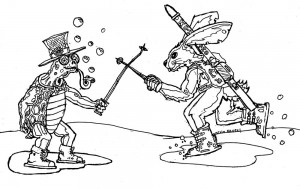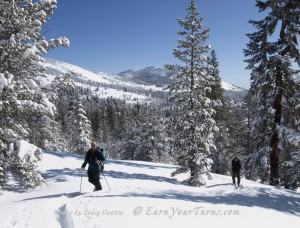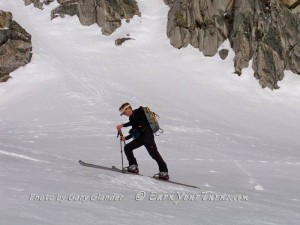It is clear from his final point, that the real reason for setting a steep skin track is the male tendency to revel in the pride of achievement. However, the true test of manliness, especially in the mountains, is to eat your humble pie while it is easily digested and recognize that the low road is the best road.
Taking the low road has several advantages. It is unquestionably more efficient, therefore, usually faster; it is consistently safer; arguably more aesthetic and, for those still intent on a challenge, is more difficult to achieve with purity, i.e., sticking to a low angle line. Those who only recognize physical challenges or are incapable of cerebral ones will miss the latter point.
Humans were designed to move predominantly in walk mode. We move forward easier than upward because our legs swing like pendulums from our hip sockets. The optimal line then is one that takes advantage of this natural movement while chipping away at gravity in small increments. Skinning at a low angle is the ultimate in low energy movement. You don’t even have to lift your knee, just shuffle it forward.
Although skins can hold on angles exceeding 30°, it takes more energy to make them hold at steep angles. This incremental energy, multiplied by several thousand steps, saps your personal energy battery quicker than taking the low road, even though the low road may cover more distance. Not only that, but the likelihood of slipping increases as the angle of attack increases. If there is one sure fire way to burn energy, it is recovering from skins slipping repeatedly. Go steep and slip they will. Go low and you’ll have more energy to take more runs during the day, leaving a bigger smile on your face when you retire for the night.
Speed
Because it is more efficient, it is also easier to quicken the pace and cover more ground, vertical included, by skinning at a low angle. As proof, consider the Elk Mountain Grand Traverse, a race between Crested Butte and Aspen where skiers summit three passes, climbing 9000 vertical feet over 40 miles of distance. The winners have universally used nordic gear, which mandates a low angle climb.
It is possible to sprint short vertical pitches for a vertical advantage, but not on a long climb and not without a break after each sprint. As you gain altitude the rests inevitably become longer than the sprints, until upward momentum stalls. Exceptions to this rule exist for mutants like Andrew McLean, who consider a 100-mile trail run “fun” (Besides for a steep line on snow, crampons or Verts are the best tool, not skins). For the rest of us, the low angle approach allows us to hold a steady pace for hours on end, while we chew up the vertical and laugh at the hare brains taking break after break on the steep line.
Aesthetics
Though I’ll admit the view from a steep route may not be inferior to the low road route, it requires such concentration to hold a steep skinning line that you rarely have the opportunity to notice the view. On the low road, however, the very necessity of scrutinizing terrain features to take advantage of the lowest line possible mandates taking in the view. Not only that, but to hold a low angle line usually requires following the contours of a mountain over several aspects. This affords more views of the winter’s majesty surrounding you, as well as giving you a first hand sampling of the snow on several aspects. The latter information helps with avalanche avoidance as well as determining the best snow for the descent. Besides, since you don’t expend all your energy holding a steep line, you’ll have enough breath left over to carry on a conversation.
Safety
In the mountains speed is safety. The less time you take, the less you are exposed to objective hazards. Furthermore, the low road generally limits your exposure to danger.
Although the macho will scoff, the technique for taking the low road actually requires more brain matter than straight lining because you have to overcome the natural tendency to climb over terrain features. If your skin track exceeds 15° of incline, you’re heading for the steep track. Twelve degrees is a good angle that even novices can follow, and you won’t need a heel lifter to skin at that angle. In fact, the best way to ensure that you stay on a low angled track is to not use heel lifters.
The art of the low road comes from setting a line that, with perfect execution, never loses elevation, never exceeds 15° of incline, never uses a sharp switchback, goes around terrain features like a topo map contour and leverages them for elevation gain while climbing at a relentless, easy pace. To the blind, such a track appears to be a hopeless exercise in futile meandering. To the experienced, however, such a line will elicit a sigh of satisfaction in the same way that fresh tracks taste sweeter when paid for with sweat.
This is a reprint of an article that first appeared in Couloir Vol. XIII-4, Winter 2001
© 2001




1 comment
4 pings
Interesting, I agree with the aesthetics but perhaps the lower climb bar isn’t too extreme? Anyway here in the East we may not have as much open terrain to choose any old angle of assent from! Have to exchange climb angle for fighting the willywhacks! (or cliffs/walls)
[…] Posts: Steep Skinning – the Hare Brained Way Low Angle Skinning – Way of the Tortoise Share this:PrintEmailShareStumbleUponDiggRedditpinterest Posted in Skinning « […]
[…] insanely steep) Tahoe skin track? Stop using those silly climbing pegs, learn how to 1) set a low angle skin track (climbing pegs make them inevitable) and 2) make a snap kick turn. It’s a lot of work to […]
[…] options for the rest of the tour.Slacker tour #2 Today the summit chair was not running so I meanderskinned through the hemlocks wearing moss coats on the north side of Mt. Judah. The surface was a thick […]
[…] I can get along with most anyone on the skin track, I prefer those who share my preference for a meanderthal track with a slow but steady pace. Those who prefer a competitive pace cease to be partners because […]